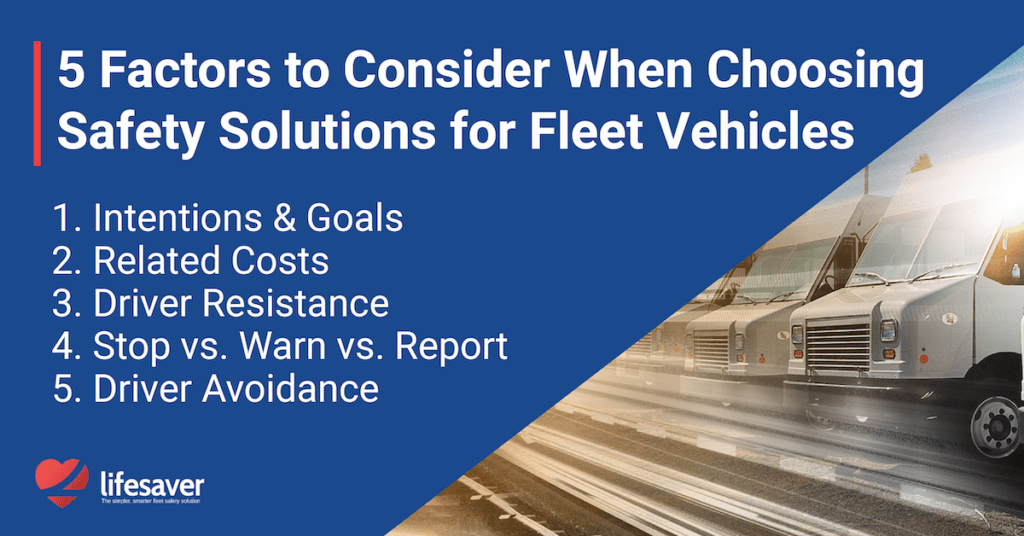There are many viable safety solutions for fleet vehicles to improve driver behavior and lessen the probability of an accident. All of these fleet safety products can help to varying degrees and at differing price points. To get the most value and the strongest ROI from a fleet safety technology investment, the fleet should consider the following elements (in no particular order) when evaluating the multitude of fleet safety solutions:
1. Starting with why: The fleet should have clear intentions and goals for implementing fleet safety technology driven by the type of business the fleet is involved in, the historically known safety issues, and the capability of various technologies to address those issues. Address behaviors like speeding that impact the severity of an accident, and driver distraction that impacts the frequency of an accident. Fleet Telematics can provide insight into driver behavior as a basis for ongoing coaching while video oriented solutions add the value of claims settlement as well as driver distraction identification and other measures of value such as following distance. Generally, technology can help with driver exoneration, claims settlement, driver behavior improvement, or by taking over vehicle control when needed.
2. Cost: Most expensive are fleet dashcam solutions and collision avoidance solutions (requiring video hardware and possible cloud storage of rich video data), followed by GPS-oriented solutions (typically with an installed obd device or black box), then phone apps (requiring no in-vehicle hardware)
3. Driver resistance: As a fleet manager, whichever safety solution for fleet vehicles you end up choosing, the proper introduction and open communication with drivers is a critical first step. The fleet should strive for positive participation from drivers, heavy on the “carrot” and light on the “stick”. The heavy lifting here is on the fleet to get buy-in from drivers. Video solutions will be most resisted by drivers and unions who may consider their use to be invasive. All technologies can be resisted for the reason of drivers feeling they are being tracked. It is important that technology provides the ability for the driver to “self correct”. Drivers find this to be a more comfortable solution and the results have proven effective. This is accomplished by near-real time audio feedback and reporting directly to the driver, only elevated to management attention upon continuance of undesired behaviors.
4. Stop vs. warn vs. report: Fleet safety solutions that depend on back-end reporting and required coaching become less effective over time (for example, OBD telematics) at modifying driver behavior. Technology that intervenes with the driver to help correct behavior is more effective (for example, audio from camera or phone that “you are going too fast”). Technology that intervenes with the vehicle directly (for example, active braking) is effective but doesn’t seek to improve driver behavior, while technology (for example, speed governor) that stops behavior is most effective but does not address other issues of safety.
5. Driver avoidance/recidivism: Drivers who receive “scorecards” or reported summaries of their driving issues will improve only with a well managed, evolving, continuous program of coaching and management oversight. Drivers who receive some type of near real-time audio feedback about their behavior will tend to self correct with much less dependence on management involvement. Drivers who have behaviors blocked have no choice but to accept. Drivers will often seek to find “work arounds” to avoid technology. For example if a driver mounts his cell phone at or behind the steering wheel, facial geometry and evaluating degree of head motion can fail to identify these infractions through video analysis.
Summary of Choosing Safety Solutions for Fleet Vehicles
Safety solutions for fleet vehicles have the proven ability to improve driver behavior. However the costs, processes, management involvement required, focus on behaviors addressed, acceptance of the technology by the drivers, and actual impact on behavior improvement vary greatly amongst the alternatives.
Various technology solutions require different levels of commitment from commercial fleets to be fully effective. If the fleet problem is either: claims settlement, lack of ability to exonerate drivers, avoidance of staged accidents, or identification of causes of driver distraction and following distance—then video is a good chance despite the higher cost. If the fleet is focused mainly on location-based intelligence but is also interested in driver behavior insight, GPS/OBD oriented solutions are appropriate as well as being less costly. If the fleet wants a low-cost solution providing insight into driver behavior and cell phone distraction, an app-based distracted driving solution can do the job, typically requiring little or no additional hardware in the vehicle.
The fleet should have a good understanding of the specific behaviors that are leading to accidents and focus attention on correcting those behaviors. The more the safety technology can provide near real-time audio feedback, the less the burden on management to be directly involved in coaching drivers.


